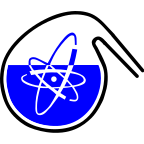Speaker
Description
In this study, we produced Tc isotopes with high energy gamma emitting for developing of Compton camera imaging instead of SPECT measurement with 99mTc. Technetium-99m is used in radioactive diagnostic tests, for example as a radioactive tracer that a nuclear medical gamma camera can detect in human body. It is well suited to the role because it emits readily detectable 141 keV gamma rays, and its half-life is 6.01 h. There are at least 31 commonly used radiopharmaceuticals based on 99mTc for imaging and functional studies of the brain, myocardium, thyroid, lungs, liver, gallbladder, kidneys, skeleton, blood, and tumors. In medical diagnostic test, -rays emit from 99mTc-labelled compound in human body are measured with Single-photon emission computed tomography (SPECT). The SPECT can achieve high position resolution using pine-hole collimator. In the SPECT measurement, the use of collimator deduces detection efficiency of gamma-rays from 99mTc remarkably. In recent years, the Compton camera which is originally developed for the astrophysical studies was applied for medical diagnostic usage. Compton camera imaging can realize high position resolution without collimator. Because of no collimator using, the Compton camera makes higher gamma-ray detection efficiency. Compared with SPECT with 99mTc, the Compton camera imaging technique can be expected that radiation exposure deduce to 10-20%. For the Compton camera imaging require technetium isotopes emitting higher energy gamma-rays. Two technetium isotopes, 95mTc and 96Tc are candidates for Compton camera imaging. The feasibility study of Compton camera imaging using gamma rays emitted from 95mTc and 96Tc was carried out. Using the ETCC (Electron Tracking Compton Camera) at Kyoto University, we obtained imaging pictures of the gamma rays emitted from 95mTc. Also recycling method of enriched Molybdenum oxide target developed in this study and the possibility of these Tc isotopes, 95m, 96Tc, of substitution for 99mTc in diagnostic will be discussed in the conference.

